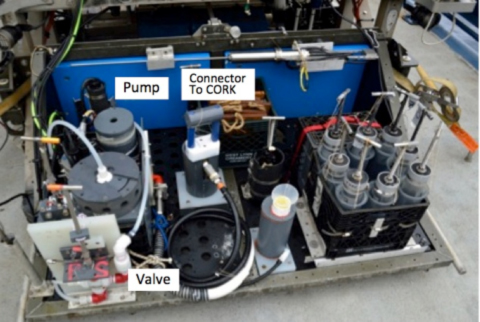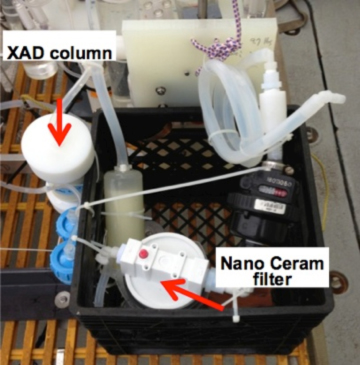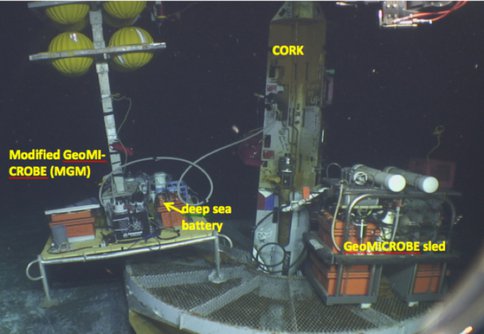2013 Annual Science Report
 University of Hawaii, Manoa
Reporting | SEP 2012 – AUG 2013
University of Hawaii, Manoa
Reporting | SEP 2012 – AUG 2013
Subsurface Exploration for Astrobiology: Oceanic Basaltic Basement Biosphere
Project Summary
While extraterrestrial life is likely to exist within the subsurface of water-occupied objects such as Enceladus and Europa, the continued investigation of the subsurface biosphere on the earth provides important insight and implications for astrobiology. This research investigates a deep sub-seafloor basement biosphere. At the ocean floor, lying underneath an often times thick layer of sediment is hard basaltic rock, or basement. Seawater enters the basement and circulates within. It is now known that low temperature hydrothermal fluids (<100oC) circulate everywhere within the porous and permeable volcanic rocks of the upper ocean basement, providing temperature and chemical gradients that host extensive alteration of basement rocks and fluids and form plausible habitats for microbial life. While microbial activity has been observed in deeply buried sediments and exposed basement rock, few direct tests have been carried out in deep subseafloor basement rocks or fluids. A majority of the crustal hydrothermal flow and seawater-crustal fluid exchange, and the corresponding advective heat and mass output, occurs on the flanks of the mid-ocean ridge with basement ages of >1 million years old. This low-temperature ridge flank flow rivals the discharge of all rivers to the ocean and is about three orders of magnitude greater than the high temperature discharge at mid-ocean ridges. The resulting ridge flank chemical flux impacts ocean biogeochemical cycles and may sustain deep basement microbial communities. Access to uncontaminated fluids from subseafloor basement is problematic, especially where ridge flanks and ocean basins are buried under thick, impermeable layers of sediment (i.e., thick enough to act as a barrier to rapid exchange of fluids). We rely on custom designed instrumentation to collect large volume high integrity basement fluids, where the concentrations of microorganisms are often very low (e.g. about 1/10 of bottom seawater concentrations). By studying the chemical composition of crustal fluids, we have learned that several important energy sources, such as dissolved methane and hydrogen, are available. In addition, the isotopic signature of dissolved methane suggests that microbial production and consumption occurs in the basement environment. By filtering microbial biomass from the fluids and investigating their nucleic acids, we are investigating the evolutionary and functional characteristics of the diverse bacterial, archaeal, and viral communities that inhabit the deep subsurface of Earth. Our on-going research includes the investigation of temporal (at hourly-resolution) and spatial (at a few hundred meter scale) biogeochemical and biological variability in order to more effectively constrain our measured parameters. We are also characterizing the dissolved organic carbon pool in basement fluids to investigate the role that basement environment plays in the global carbon cycle.
Project Progress
The permeable rocks of the upper oceanic basement contain seawater-sourced fluids estimated to be ~2% of the global ocean volume. This represents a very large potential subsurface biosphere supported by chemosynthesis. Recent collection of high integrity samples of basement fluid from the sedimented young basaltic basement on the Juan de Fuca Ridge flanks, off the coasts of Vancouver Island (Canada) and Washington (USA), and subsequent chemical analyses permit numerical modeling of metabolic redox reaction energetics. The values of Gibbs free energy for potential chemolithotrophic net reactions were calculated in basement fluid and in zones where basement fluid and entrained seawater may mix. In pure basement fluid, energy yields from the anaerobic respiration processes investigated are anemic, releasing <0.3 J/kg basement fluid for all reactions except methane oxidation by ferric iron, which releases ~0.6 J/kg basement fluid. In mixed solutions, aerobic oxidation of hydrogen, methane, and sulfide are the most exergonic on a per mole electrons basis. Per kg of basement fluid, the aerobic oxidation of ammonia is by far the most exergonic at low temperature and high seawater: basement fluid ratio, decreasing by more than two orders of magnitude at the highest temperature (63°C) and lowest seawater: basement fluid ratio investigated. Compared with mixing zones in deep-sea hydrothermal systems, oceanic basement aquifers appear to be very low energy systems, but because of their expanse, may support what has been labeled the ‘starving majority’.
Project members participated in an expedition to the eastern Juan de Fuca Ridge flank (R/V Atlantis AT26-03, with ROV Jason; 12-26 July 2013). Cowen, Lin, Hsieh, Rappé, Steward, Jungbluth, Nigro, Omori and Bowers prepared and packed the shipboard and sampling gear. All team members except Cowen, Lin and Rappé represented Cowen and UHNAI to sail on the expedition. This expedition employed remotely-operate-vehicle (ROV) Jason in order to (1) recover an autonomous pumping and sampling system, GeoMICROBE sled (Figure 1), which was deployed on the seafloor in July 2011; (2) collect large volume basement fluids using a novel mobile pumping system (MPS, Figure 2); and (3) filter large volume basement fluids in situ using a modified GeoMICROBE sled (MGM, Figure 1). Deep crustal fluids were pumped from several hundreds of meters below the seafloor and collected onto filters or within acid-washed and sterile samplers at the seafloor.
The recovered GeoMICROBE sled faithfully filtered and collected high integrity basement fluids at a monthly-resolution, as preprogramed. The resulting filters are currently being processed in order to look for colloidal tracers (fluorescence microspheres) that simulate microorganisms and were injected during a large-scale, long-term and cross-hole experiment initiated in October 2010. This will provide unprecedented insight into the dispersal properties of this remote biosphere. With the MPS, several large-volume (up to 600L) and high-integrity basement fluids were also retrieved. Multiple deployments of MGM also allowed us to filter basement fluids on the seafloor with minimum submersible time, resulting in up to 5,500 L of basement fluid filtered through a single cartridge (Figure 3). Due to low concentrations of biomass and viruses, these large volume samples facilitate a breadth of research not otherwise possible with small volume samples. These samples are now being analyzed for a suite of geochemical, microbiological (e.g. biomass, genomics, transcriptomics, metabolic characteristics) and virological (e.g. virus concentration, molecular diversity, viral activities) parameters. Metabolic experiments are planned in order to obtain the potential metabolic rates of basement microorganisms. In addition, a large amount of dissolved organic carbon (DOC) was collected for the characterization of its composition so that we can begin to understand the reactivity of the organic carbon pool.


Publications
-
Boettger, J., Lin, H-T., Cowen, J. P., Hentscher, M., & Amend, J. P. (2013). Energy yields from chemolithotrophic metabolisms in igneous basement of the Juan de Fuca ridge flank system. Chemical Geology, 337-338, 11–19. doi:10.1016/j.chemgeo.2012.10.053
-
Jungbluth, S. P., Lin, H-T., Cowen, J. P., Glazer, B. T., & Rappé, M. S. (2014). Phylogenetic diversity of microorganisms in subseafloor crustal fluids from Holes 1025C and 1026B along the Juan de Fuca Ridge flank. Frontiers in Microbiology, 5. doi:10.3389/fmicb.2014.00119
-
Rappé, M. S. (2013). Stabilizing the foundation of the house that ‘omics builds: the evolving value of cultured isolates to marine microbiology. Current Opinion in Microbiology, 16(5), 618–624. doi:10.1016/j.mib.2013.09.009
- Biddle, J.F., Jungbluth, S.P., Lever, M.A. & Rappé, M.S. (2013). Life in the oceanic crust. In: Kallmeyer, J. (Eds.). Life in “Extreme Environments.
- Lin, H-T., Cowen, J.P., Olson, E.J., Lilley, M.D., Jungbluth, S.P., Rappé, M.S. & Wilson, S.T. (2013). Biogeochemistry of dissolved methane and hydrogen within basement fluids of the sediment-buried Juan de Fuca Ridge flank at CORK-fitted boreholes 1362A, 1362B, and 1301A. Earth and Planetary Science Letters.
-
PROJECT INVESTIGATORS:
-
PROJECT MEMBERS:
James Cowen
Project Investigator
Robert Bowers
Collaborator
Sean Jungbluth
Collaborator
Huei-Ting Lin
Collaborator
Olivia Nigro
Collaborator
Everett Omori
Collaborator
Michael Rappe
Collaborator
Daniel Repeta
Collaborator
Grieg Steward
Collaborator
-
RELATED OBJECTIVES:
Objective 4.1
Earth's early biosphere.
Objective 5.1
Environment-dependent, molecular evolution in microorganisms
Objective 5.2
Co-evolution of microbial communities
Objective 5.3
Biochemical adaptation to extreme environments
Objective 6.1
Effects of environmental changes on microbial ecosystems
Objective 6.2
Adaptation and evolution of life beyond Earth
